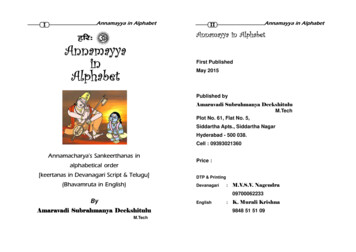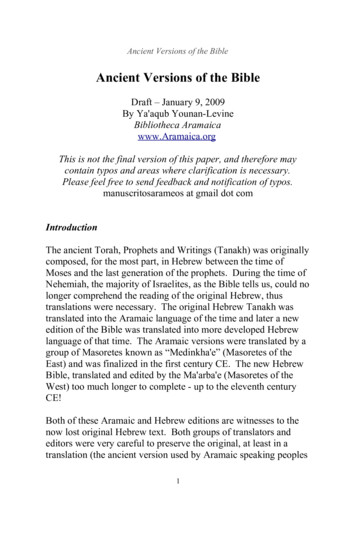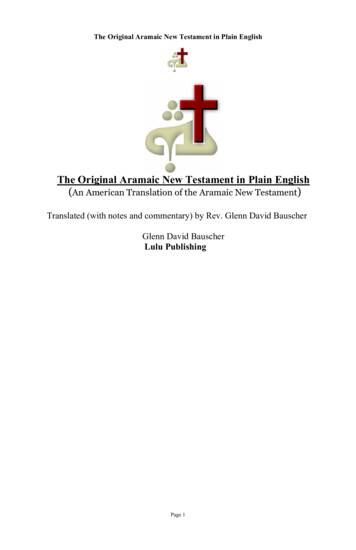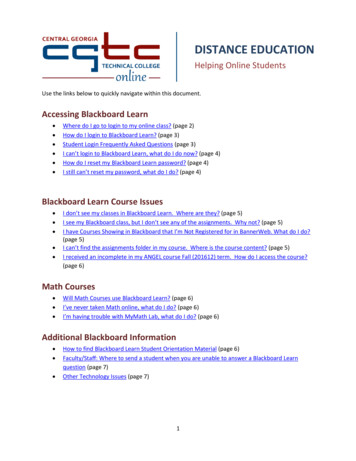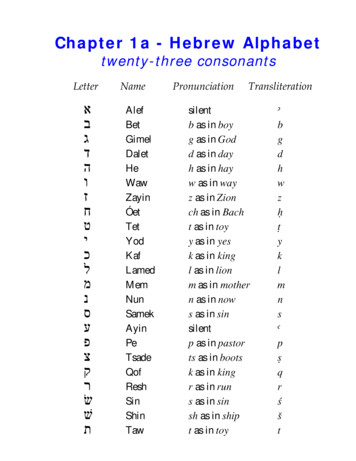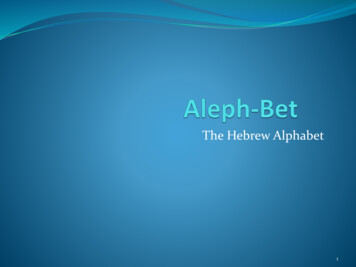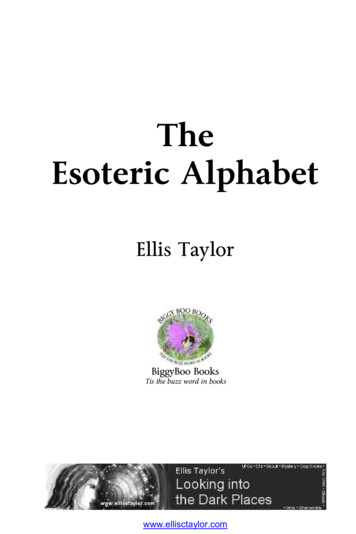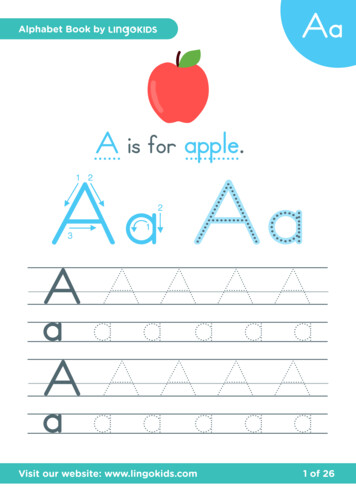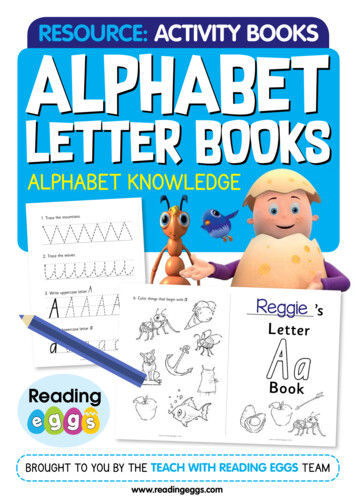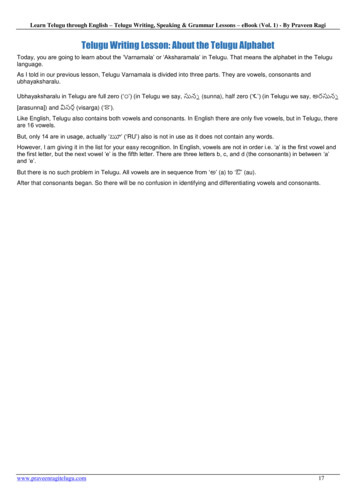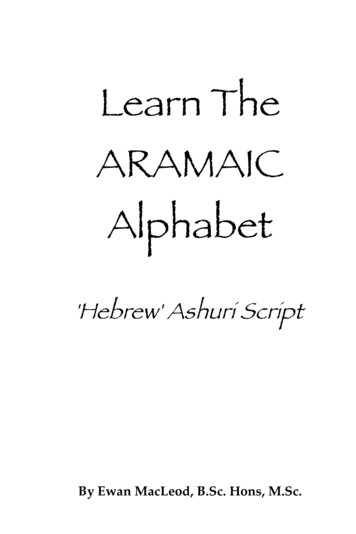
Transcription
Learn TheARAMAICAlphabet'Hebrew' Ashuri ScriptBy Ewan MacLeod, B.Sc. Hons, M.Sc.
2LEARNTH E AR A MA I C AL P H AB ET – 'HE B R EW' AS H U R I SC R I P TEwan MacLeod is the creator of the following k.comBibleManuscriptSociety.comCopyright Ewan MacLeod, JesusSpokeAramaic.com, 2015.All Rights Reserved. No part of this publication may be reproduced, stored in, or introduced into,a retrieval system, or transmitted, in any form, or by any means (electronic, mechanical, scanning,photocopying, recording or otherwise) without prior written permission from the copyrightholder.The right of Ewan MacLeod to be identified as the author of this work has been asserted by himin accordance with the Copyright, Designs and Patents Act 1988.This book is sold subject to the condition that it shall not, by way of trade or otherwise, be lent,resold, hired out, or otherwise circulated without the copyright holder's prior consent, in anyform, or binding, or cover, other than that in which it is published, and without a similarcondition, including this condition, being imposed on the subsequent purchaser.Jesus Spoke AramaicTM is a Trademark.
3Table of ContentsIntroduction To These Lessons.5How Difficult Is Aramaic To Learn?.7Introduction To The Aramaic Alphabet And Scripts.11How To Write The Aramaic Letters. 19Letter Alap. 22Letter Beet. 25Letter Gamal. 29Letter Dalat. 32Letter Heh. 35Letter Waw. 38Letter Zeyn. 41Letter Chet. 44Letter Tet. 48Letter Yud. 51Letter Kap. 56Letter Lamad.60Letter Meem. 63Letter Noon. 66Letter Semkat. 69Letter Ey.72Letter Pe. 76Letter Tsadeh. 80Letter Kop. 83Letter Resh. 86
4LEARNTH E AR A MA I C AL P H AB ET – 'HE B R EW' AS H U R I SC R I P TLetter Sheen. 89Letter Taw. 94Summary Of Letters With Final Forms.97Summary of Letters That Look Alike. 100Congratulations!. 104Introduction To Vowels In Aramaic.105Why English NEEDS Vowels. 108Why Aramaic Is Different. 112The Mothers Of Reading. 116The History Of The Aramaic Vowels. 119Vowel Hireq. 122Vowel Holem. 124Vowel Shurek. 125Vowel Kubbuts. 126Vowel Patach. 128Vowel Kamets. 129Vowel Sere. 130Vowel Segol. 131Shwa. 132Dagesh. 134Using Aramaic Flashcards. 135And Now For Some Reading Practice.137Where To Go From Here. 148About Ewan MacLeod. 152Visit JesusSpokeAramaic.com. 154
I N TRODU CTION TO TH E S E LE S S O N S5Introduction To These LessonsWELCOME TO these lessons on the Aramaic Alphabet, onthe 'Hebrew' Ashuri script. The Alphabet, and the Ashuriscript in particular, is the starting point for learning Aramaic,and the foundation upon which everything else is built.The Ashuri script is the oldest of the Aramaic scripts. It goes back tothe Aramaic that the Jews used in Babylon, and in fact this script wassubsequently adopted by the Jews. It was used to preserve theHebrew Bible, and for everything else in Judaism, including its use inIsrael today.An Aramaic Alphabet DVD of video lessons to accompany this book isavailable on the JesusSpokeAramaic.com website, at the following AshuriIdeally you should subscribe to JesusSpokeAramaic.com to get fullaccess to the whole series of accompanying video lessons, or buy theDVD, or both. You can subscribe using the link below:JesusSpokeAramaic.com/SubscribeWhile this book is designed to be used for self-study or in a classroomsituation, there are many concepts that can really only be taught bywatching the above video lessons on the website. For example, learninghow to read, write and pronounce the letters is much easier when youhave access to the video lessons. On the other hand, this book allowsyou to read through the material at your leisure, study it, and writeyour own notes on the pages.To make the best progress, just start at the beginning, and keep going!It sounds obvious, but most people don't do that they either don'tstart, or start but do not keep going because the task seems so big!
6LEARNTH E AR A MA I C AL P H AB ET – 'HE B R EW' AS H U R I SC R I P TWork your way steadily through the lessons, practice the material,watch the video lessons, and keep going. That way, you will make goodprogress, and you will be ready to make even further progress in yourAramaic studies.
H O W DIFFIC U LT IS AR A MA I C TO LE A R N?7How Difficult Is Aramaic ToILearn?AM SURE you have already seen the letters of the AramaicAlphabet, perhaps in the context of Biblical Aramaic, or throughthe pages of the Peshitta New Testament, the Peshitta OldTestament or the Targums. Here is an example of the 'Hebrew' AshuriAramaic script which we will be learning in this book:
8LEARNTH E AR A MA I C AL P H AB ET – 'HE B R EW' AS H U R I SC R I P TPerhaps you have already tried to learn the Aramaic Alphabet or evensome Aramaic grammar. In these lessons on the Aramaic Alphabet, youwill gradually be introduced to each of the Aramaic letters in turn, howto write them, and how to pronounce them. We often compare theAramaic letters to their corresponding Hebrew letters, because if youknow Hebrew, learning Aramaic will be much easier.You can watch the accompanying video for this lesson from the link et/HowDifficult-to-LearnIf the Aramaic Alphabet is new to you, at first everything will seemstrange and unfamiliar. Because the Aramaic letters look so differentfrom English, many people assume that Aramaic must be a difficultlanguage to learn.But once you have overcome the initial shock of how different theAramaic Alphabet looks when compared with English, how strange theletters seem and how different the vocabulary and sounds of thelanguage are, Aramaic really isn't any harder to learn than any otherlanguage.In fact, Aramaic is perhaps easier to learn than other languages,because the working vocabulary is relatively small, and certainfundamental concepts run all the way through the language frombeginning to end. Once you know the Aramaic Alphabet, everythingtends to fall into place, and progress in actually reading andunderstanding the Aramaic of the Peshitta, Biblical Aramaic or theTargums can be surprisingly fast. If you systematically work your waythrough all these lessons (and ideally watch the video lessons on theJesusSpokeAramaic.com website), one day you will find that you canpick up the Peshitta New Testament and other writings in Aramaic, andunderstand the Aramaic. You will be able to appreciate the depth and
H O W DIFFIC U LT IS AR A MA I C TO LE A R N?9wisdom of the Biblical writings much better, and understand the trueworth and wealth of the Holy Scriptures.There is a Hebrew proverb, Kol techilot kashot , which means Allbeginnings are difficult . Starting to learn the Aramaic Alphabet will bedifficult at first, but if you take it step by step, you will soon be amazedat how much progress you have made. The hardest step, however, is toactually begin, and to learn the Aramaic Alphabet.The more progress you make, the easier the journey will get. It's wellworth the effort. What could be more wonderful and exciting than topick up the Aramaic New Testament, and understand the actual wordsspoken by Jesus, or Paul? A translation of the Aramaic, however good,is only a translation, and does not convey the beauty and majesty ofthe original inspired and God-breathed Scriptures. Reading atranslation is like looking at a photocopy of a beautiful work of art –but nothing is more beautiful and awe-inspiring than looking at theoriginal in all its depth and beauty.Although all beginnings are hard, the journey is worthwhile and will bemore rewarding than you can possibly imagine. Alongside Hebrew,Aramaic is one of the Holy Languages of the Bible, given by God toman to reveal His Word. However difficult the path might be, and with allhumility, set your heart to understand Aramaic, starting with theAlphabet.Aramaic is a fascinating language, full of beauty and simplicity and yetpowerful enough to express the complexities of a modern civilization.Like Hebrew, it is still spoken today. Not only will the study of Aramaicallow you to read the Aramaic New Testament in its original languageafter the passage of thousands of years, but you will also be receivinga solid foundation in learning Hebrew. And Hebrew is the gateway tolearning the Tanakh, the Hebrew Bible. Hebrew and Aramaic togetherare the languages God has used to reveal His Word, in both the Oldand New Testaments.
10LEARNTH E AR A MA I C AL P H AB ET – 'HE B R EW' AS H U R I SC R I P TSo what are you waiting for? Start learning the Aramaic Alphabettoday!
I N TRODU CTION TO TH E AR A MA I C AL P H AB ET AN D SC R I P TS11Introduction To The AramaicAAlphabet And ScriptsS YOU MAY know from my book “ Discover Aramaic – TheBible's SECOND Holy Language ” (available as a freedownload from the website) Aramaic has a long anddistinguished history, going back more than 4000 years. Thoughworld empires have come and gone, though world leaders have risenand fallen, though Aramaic itself has survived as it has watched manyother of the world's languages disappear into the mists of time, wehave seen that Aramaic is still spoken today, and is still recognisablythe same language as it always was, down through more than fortycenturies of human history.You can download the book Discover Aramaic – The Bible's SECOND HolyLanguage from the link amaic-BookNothing remains the same over such a long period of time, and Aramaicis no exception. As Aramaic has been spoken, written and used acrossmany different continents and countries, writing styles have inevitablychanged. If we compare Aramaic with English, we find that a similarthing has happened to English, too. If you compare a modern printedbook with an early Tyndale New Testament, or an early Geneva Bible orKing James Bible, the shape and form of English letters has changedso much that most people, without a lot of practice, would find itdifficult to read the text of an old Bible.Similarly, if we compare modern printed Hebrew Bibles to the scriptused in the Dead Sea Scrolls, for instance, we find that (although they
12LEARNTH E AR A MA I C AL P H AB
Perhaps you have already tried to learn the Aramaic Alphabet or even some Aramaic grammar. In these lessons on the Aramaic Alphabet, you will gradually be introduced to each of the Aramaic letters in turn, how to write them, and how to pronounce them. We often compare the Aramaic letters to their corresponding Hebrew letters, because if you know Hebrew, learning Aramaic will be much easier .
